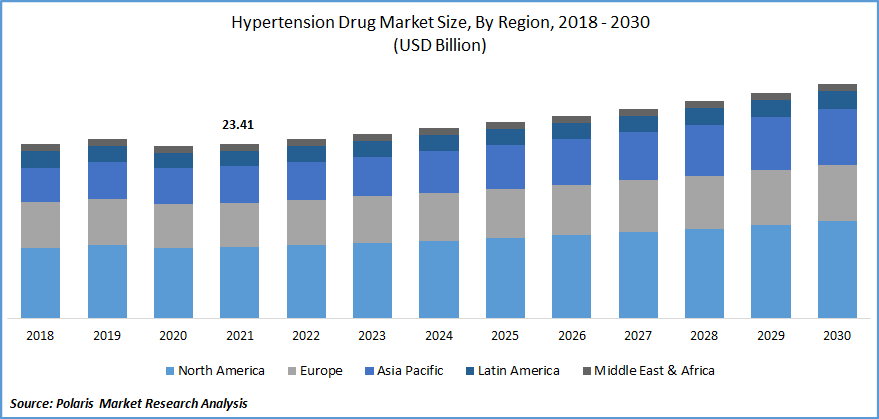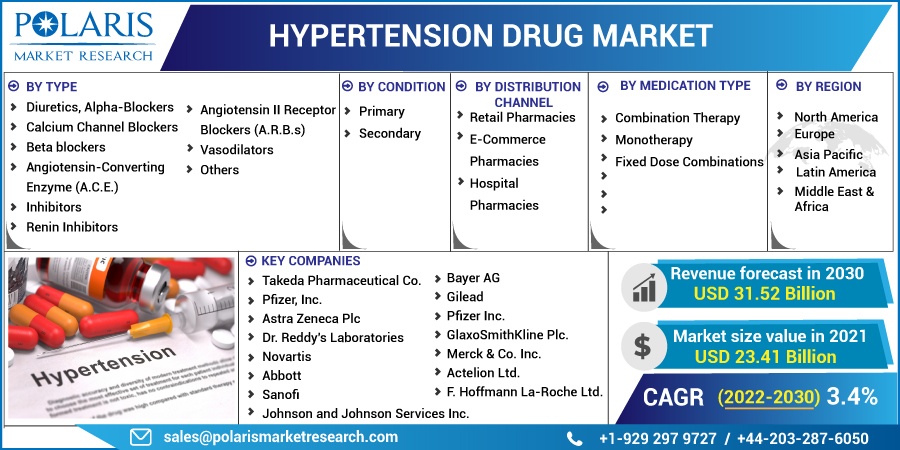
Hypertension Drug Market Share, Size, Trends, Industry Analysis Report, By Distribution Channel (Retail Pharmacies, E-Commerce Pharmacies, Hospital Pharmacies); By Condition (Primary, Secondary); By Type; By Medication Type; By Region; Segment Forecast, 2022 - 2030
- Published Date:Sep-2022
- Pages: 101
- Format: PDF
- Report ID: PM1331
- Base Year: 2021
- Historical Data: 2018-2020
Report Summary
The global hypertension drug market was valued at USD 23.41 billion in 2021 and is expected to grow at a CAGR of 3.4% during the forecast period. The term hypertension is also used to refer to high blood pressure. It is a condition in which there is an excessive force of blood against the walls of the arteries. It rarely has prominent symptoms. A person with hypertension typically has blood pressure over 140/90, and those with hypertension over 180/120 are considered severe.

Know more about this report: Request for sample pages
There are various ways people can suffer from hypertension, which include obesity, excessive alcohol consumption, smoking, disturbed sleep, not doing sufficient exercise, and not eating a balanced diet. According to the World Health Organization, more than 1 billion people suffer from hypertension.
Over the forecast period, only 1 in 5 of these individuals are cured or under control, which will lead to growth in the hypertension drug market. Additionally, the rise in awareness related to hypertension diseases, the increase in geriatric patients, and the rise in inactive patients are the prominent factors boosting the market's growth.

Know more about this report: Request for sample pages
Industry Dynamics
Growth Drivers
The rising prevalence of diabetes is the main factor fueling the expansion of the market for drugs to treat hypertension. Furthermore, technological advancements and an aging population are driving the global hypertension drug market. Moreover, the market is growing because of rising healthcare costs, cardiovascular diseases, and tobacco use.
The health benefits associated with hypertension drugs have a positive impact on the market's growth. Angiotensin-converting enzyme (A.C.E.) inhibitors aid in reducing mortality and morbidity in cardiovascular patients, but unlike angiotensin II receptor blockers (A.R.B.s), they don't cause cough. Therefore, the launch of innovative drug/therapeutic molecules with disease-modifying properties and improved efficacy and safety is expected to drive the global antihypertensive drug market in the next few years.
Report Segmentation
The market is primarily segmented based on type, condition, medication, distribution channel and region.
|
By Type |
By Condition |
By Distribution Channel |
By Medication Type |
By Region |
|
|
|
|
|
Know more about this report: Request for sample pages
Angiotensin II receptor blockers segment is expected to witness the fastest growth
In 2022, the angiotensin II receptor blockers segment accounted for the largest market share. Angiotensin II receptor blockers (A.R.B.s) help treat high blood pressure, heart failure, and chronic kidney disease. It reduces blood pressure by relaxing the veins and arteries and makes it easier for the heart to pump blood. It is a chemical in a patient's body that constricts the blood vessels.
This restraint can increase blood pressure and force patients' hearts to work smoother. Angiotensin II receptor blockers (A.R.B.s), a different class of blood pressure medication, have a similar effect to angiotensin-converting enzyme (A.C.E.) inhibitors but do so through another mechanism. It can only cause a dry cough.
For instance, examples of angiotensin II receptor blockers including, Eprosartan, Candesartan (Atacand), Valsartan (Diovan), Azilsartan (Edarbi), Irbesartan (Avapro), Olmesartan (Benicar), Telmisartan (Micardis), Losartan (Cozaar). Angiotensin II receptor blockers (A.R.B.s) have few side effects. They can have side effects, including headaches, angioedema (swelling of the skin caused by an accumulation of fluid), dizziness, and nausea, just like any medication. These may improve in a few days.
Primary hypertension accounted for the second-largest market share in 2021
Primary hypertension is a type of high blood pressure that has no identifiable symptoms. It is also known as essential hypertension. It is linked to genetics, a deficient diet, lack of exercise, excessive salt, and obesity. It is by far the most common form of primary hypertension.
It is anticipated that during the forecast period, the primary hypertension segment will hold the second-largest market share in the global market. The demand for hypertension medications will grow at a significant CAGR during the forecast period as public awareness of hypertension and high blood pressure increases along with cutting-edge research in drug development.
Hospital pharmacies are expected to hold the significant revenue share
In 2022, the hospital pharmacies segment accounted for the largest market share. It is because of the rise in hospital all around the world. Hospital pharmacies usually accumulate a wide range of medicines, including specialized and investigational drugs.
Hospital pharmacies are increasing the availability of the most delinquent medicines to broaden their income sources. Furthermore, the drugs are frequently prescribed, and the prescriptions are usually given by specialized healthcare professionals and can be found in hospitals. This is a substantial reason for the growth in the market demand for this segment.
Combination therapy is expected to hold the significant revenue share
The combination therapy segment is projected to dominate the market share in the global industry during the forecast period. Combination therapy has a more significant antihypertensive effect than high monotherapy doses because it adds multiple mechanisms of action that block different pathways that lead to high blood pressure. It also offers more excellent protection for the target organs than monotherapy and has a lower risk of side effects.
In addition to reducing cerebrovascular events by half, it also reduces coronary issues significantly. This is why combination therapy is better than monotherapy because it gives a lower dose to protect the organ. It is also accepted more broadly all over the world. This can make it a lucrative market for companies that want to invest here.
The demand in North America is expected to witness significant growth
Globally, North America garnered largest revenue share. This growth is primarily due to surge in cases of lifestyle borne diseases, high awarenesss among individuals towards its ill effects, and the presence of well-developed medical infrastructure.
Both U.S., and Canada have people with high disposable income, and awareness regarding heart atack and other cardiovascular disorders, is expected to drive the global hypertension drug market over the forecast period.
The high adoption of hypertension drugs in the U.S., an increase in approvals for new medicines by the U.S., and a rise in the rate of people suffering from cardiovascular disorders in the U.S. and Canada hold North America's significant market share.
The Asia Pacific is expected to be the fastest growing in the global hypertension drug industry over the forecast period. People are becoming more concerned about their health in the wake of the pandemic, which is expected to stimulate the demand for the hypertension drug industry.
Competitive Insight
There are several major players operating in the global market, including Takeda Pharmaceutical Co., Pfizer, Inc., Astra Zeneca Plc, Dr. Reddy's Laboratories, Novartis, Abbott, Sanofi, Bayer AG, Johnson and Johnson Services Inc., Gilead, Pfizer Inc., GlaxoSmithKline Plc., Merck & Co. Inc., Actelion Ltd., and F. Hoffmann La-Roche Ltd.
Recent Developments
In December 2021, Dr. Reddy's Laboratories launched Valsartan tablets in the United States for the treatment of high blood pressure and heart collapse. The U.S. Food and Drug Administration (USFDA) has approved Diovan's generic therapeutic substitute.
Furthermore, in December 2018, Bayer AG got a grant from the F.D.A. (Food and Drug Administration) for the device identification for artificial intelligence software for Chronic Thromboembolic Pulmonary Hypertension (CTPH) Pattern Recognition.
Hypertension Drug Market Report Scope
|
Report Attributes |
Details |
|
Market size value in 2021 |
USD 23.41 billion |
|
Revenue forecast in 2030 |
USD 31.52 billion |
|
CAGR |
3.4% from 2022 – 2030 |
|
Base year |
2021 |
|
Historical data |
2018 – 2020 |
|
Forecast period |
2022 – 2030 |
|
Quantitative units |
Revenue in USD million/billion and CAGR from 2022 to 2030 |
|
Segments covered |
By Form, By Product, By Application, By Region |
|
Regional scope |
North America, Europe, Asia Pacific, Latin America; Middle East & Africa |
|
Key companies |
Takeda Pharmaceutical Co., Pfizer, Inc., Astra Zeneca Plc, Dr. Reddy's Laboratories, Novartis, Abbott, Sanofi, Bayer AG, Johnson and Johnson Services Inc., Gilead, Pfizer Inc., GlaxoSmithKline Plc., Merck & Co. Inc., Actelion Ltd., F. Hoffmann La-Roche Ltd. |
License and Pricing
Purchase Report Sections
- Regional analysis
- Segmentation analysis
- Industry outlook
- Competitive landscape
Connect with experts
Suggested Report
- Facades Market Trend Analysis Research Report, Size & Forecast, 2017 - 2026
- Internet of Things (IoT) in Healthcare Market Research Report, Size, Share & Forecast by 2017 - 2025
- Amino Acids Market Share, Size, Trends, Industry Analysis Report, 2022 - 2030
- Aircraft Fairings Market Share, Size, Trends, Industry Analysis Report, 2020-2026
- Automotive Lightweight Material Market Share, Size, Trends, Industry Analysis Report, 2020-2027

